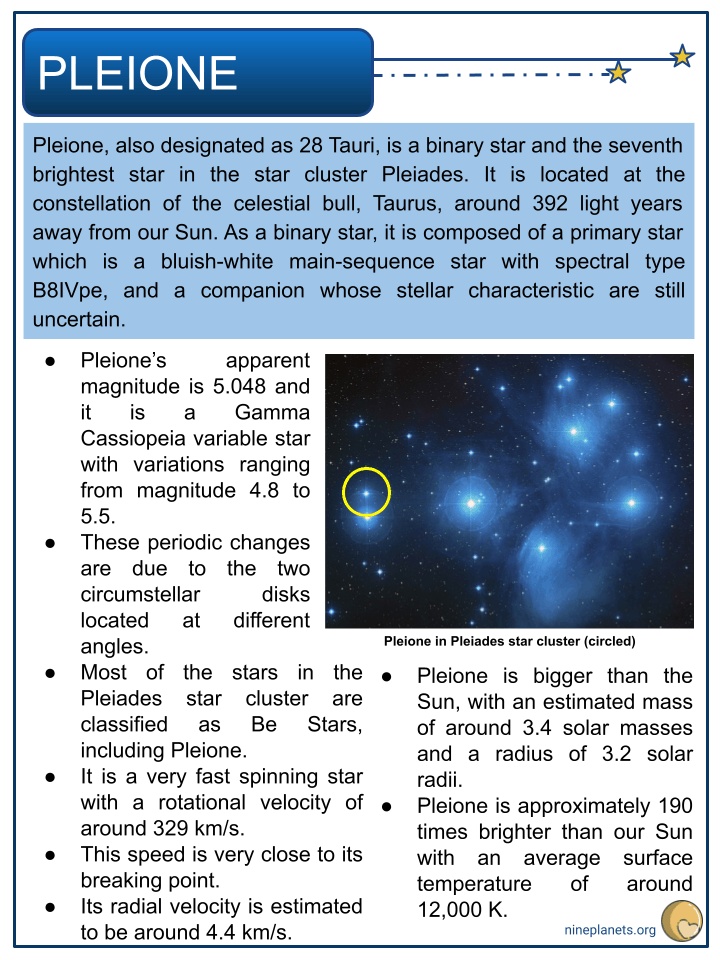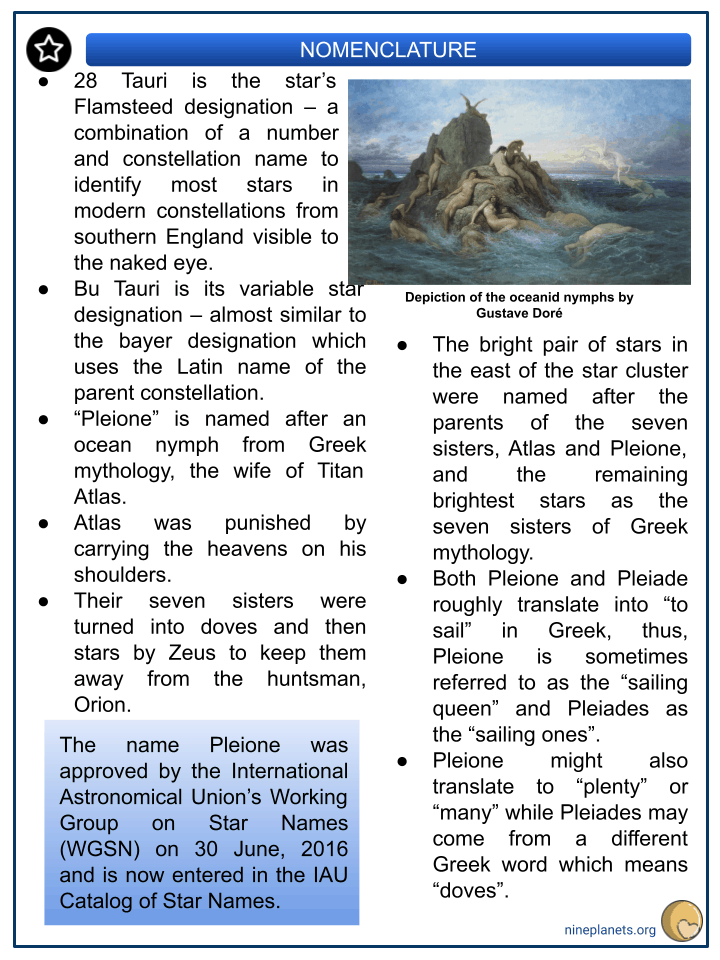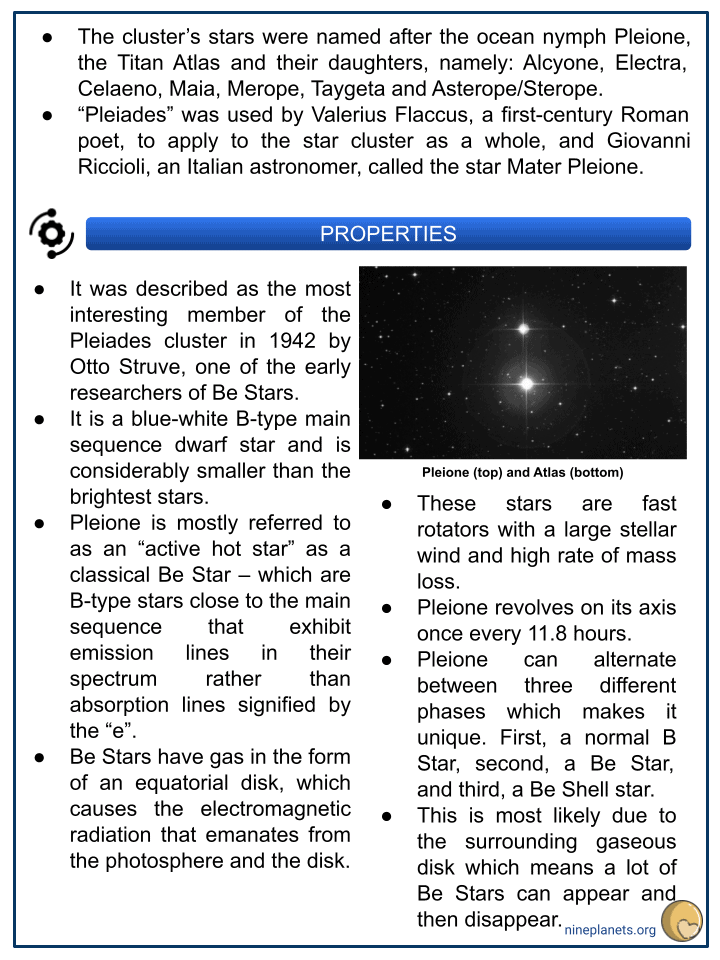Download Pleione Worksheets
Click the button below to get instant access to these premium worksheets for use in the classroom or at a home.

This worksheet can be edited by Premium members using the free Google Slides online software. Click the Edit button above to get started.
Download free sample
Not ready to purchase a subscription yet? Click here to download a FREE sample of this worksheet pack.
Resource Examples
Click any of the example images below to view a larger version.




Key Facts & Information
- Pleione, also designated as 28 Tauri, is a binary star and the seventh brightest star in the star cluster Pleiades. It is located at the constellation of the celestial bull, Taurus, around 392 light years away from our Sun. As a binary star, it is composed of a primary star which is a bluish-white main-sequence star with spectral type B8IVpe, and a companion whose stellar characteristic are still uncertain.
- Pleione’s apparent magnitude is 5.048 and it is a Gamma Cassiopeia variable star with variations ranging from magnitude 4.8 to 5.5.
- These periodic changes are due to the two circumstellar disks located at different angles.
- Most of the stars in the Pleiades star cluster are classified as Be Stars, including Pleione.
- It is a very fast spinning star with a rotational velocity of around 329 km/s.
- This speed is very close to its breaking point.
- Its radial velocity is estimated to be around 4.4 km/s.
- Pleione is bigger than the Sun, with an estimated mass of around 3.4 solar masses and a radius of 3.2 solar radii.
- Pleione is approximately 190 times brighter than our Sun with an average surface temperature of around 12,000 K.
Nomenclature
- 28 Tauri is the star’s Flamsteed designation – a combination of a number and constellation name to identify most stars in modern constellations from southern England visible to the naked eye.
- Bu Tauri is its variable star designation – almost similar to the bayer designation which uses the Latin name of the parent constellation.
- “Pleione” is named after an ocean nymph from Greek mythology, the wife of Titan Atlas.
- Atlas was punished by carrying the heavens on his shoulders.
- Their seven sisters were turned into doves and then stars by Zeus to keep them away from the huntsman, Orion.
- The name Pleione was approved by the International Astronomical Union’s Working Group on Star Names (WGSN) on 30 June, 2016 and is now entered in the IAU Catalog of Star Names.
- The bright pair of stars in the east of the star cluster were named after the parents of the seven sisters, Atlas and Pleione, and the remaining brightest stars as the seven sisters of Greek mythology.
- Both Pleione and Pleiade roughly translate into “to sail” in Greek, thus, Pleione is sometimes referred to as the “sailing queen” and Pleiades as the “sailing ones”.
- Pleione might also translate to “plenty” or “many” while Pleiades may come from a different Greek word which means “doves”.
- The cluster’s stars were named after the ocean nymph Pleione, the Titan Atlas and their daughters, namely: Alcyone, Electra, Celaeno, Maia, Merope, Taygeta and Asterope/Sterope.
- “Pleiades” was used by Valerius Flaccus, a first-century Roman poet, to apply to the star cluster as a whole, and Giovanni Riccioli, an Italian astronomer, called the star Mater Pleione.
Properties
- It was described as the most interesting member of the Pleiades cluster in 1942 by Otto Struve, one of the early researchers of Be Stars.
- It is a blue-white B-type main sequence dwarf star and is considerably smaller than the brightest stars.
- Pleione is mostly referred to as an “active hot star” as a classical Be Star – which are B-type stars close to the main sequence that exhibit emission lines in their spectrum rather than absorption lines signified by the “e”.
- Be Stars have gas in the form of an equatorial disk, which causes the electromagnetic radiation that emanates from the photosphere and the disk.
- These stars are fast rotators with a large stellar wind and high rate of mass loss.
- Pleione revolves on its axis once every 11.8 hours.
- Pleione can alternate between three different phases which makes it unique. First, a normal B Star, second, a Be Star, and third, a Be Shell star.
- This is most likely due to the surrounding gaseous disk which means a lot of Be Stars can appear and then disappear.
- At certain times, Be Stars will form multiple gas rings or decretion disks, with distinct evolution, creating complex circumstellar dynamics.
- These dynamics resulted in the prominent long-term photometric and spectroscopic variations exhibited by Pleione encompassing a period of about 35 years.
- Pleione entered a Be Shell phase in 1972 and developed many shell absorption lines in its spectrum.
- The star showed a decrease in brightness at the end of 1971.
- It gradually brightened after reaching its minimum brightness in late 1973.
- Pleione entered a Be phase in 1989.
- Pleione is a single-lined spectroscopic binary star discovered in the year 1996 by a group of Japanese and French astronomers. The angular diameter between the two stars is around 0.2 arcseconds or 24 AU which was listed by the Washington Double Star Catalogue.
- Pleione in the Future
- Pleione, together with the other stars of Pleiades, will continue to exist for another 250 million years and will disperse due to the gravitational interactions with its galactic neighbourhood, according to computer simulations.
Stellar System
- Pleione is a single-lined spectroscopic binary star discovered in the year 1996 by a group of Japanese and French astronomers.
- The angular diameter between the two stars is around 0.2 arcseconds or 24 AU which was listed by the Washington Double Star Catalogue.
- Pleione, together with the other stars of Pleiades, may have formed 70 to 150 million years ago.
- These stars formed through a gigantic molecular cloud of dust and gas.
- The swirling gas and dust were pulled together by gravity, forming the Pleiades star cluster.
- Both mythology and science considered the Pleiades to be sibling stars as modern astronomers claim that Pleiades stars were born from the same cloud of gas and dust about 100 million years ago and these stars drift together at about 25 miles per second or 40 kilometres per second. Many of this cluster’s stars brightly shine hundreds of times more than the Sun.
- Pleione was an oceanid nymph of the Mount Kyllene in Arkadia or southern Greece.
- She is one of the three thousand daughters of the Titan Oceanus and Tethys.
- Pleione is the wife of Titan Atlas and the mother of the Hyas, Hyades and Pleiades.
- In Greek mythology, the nymphs were the spirits of nature, thus, oceanids are the spirits of the sea.
- They were still very much venerated as the protectors of the natural world even though they are considered lesser divinities.
Locating Pleione
- First locate the Orion constellation and draw an imaginary line using Orion’s belt, Alnitak, Alnilam and Mintaka, then follow it passing through its bow.
- The first bright star you will see past Orion’s bow is the eye of the bull, Aldebaran, which means “follower” in Arabic as it follows the Pleiades across the sky.
- Past the eye of Taurus, you will see the Pleiades star cluster which has an arrangement of stars similar to Ursa Major and Ursa Minor.
- You will see two bright star that are near to each other and the fainter one is Pleione.
Did You Know?
- The Pleiades is believed to be formed from a compact configuration which resembled the Orion Nebula.
- The Pleiades star cluster was already known even in ancient times. The Nebra sky disk, a bronze artefact from 1,600 BC uncovered in Germany, shows one of the earliest depictions of the star cluster and its stars.
- The star cluster is also mentioned in a lot of famous and ancient texts such as Homer’s Iliad and Odyssey, Hesiod’s Works and Days, the Bible, the ancient Egyptian Calendar of Lucky and Unlucky Days, and the Japanese Kojiki.
- Pleione also has other stellar designated names: 28 Tau, BU Tau, BD+23°558, GC 4587, HD 23862, HIP 17851, HR 1180, and SAO 76229.
- Galileo Galilei first observed the star cluster through a telescope and discovered that Pleiades has a lot of dim stars that are not visible to the naked eye.
- Sidereus Nuncius or Starry Messenger is a treatise published by Galilei in 1610 which includes a sketch of the cluster with 36 stars.
- Among the nine brightest stars of the Pleiades star cluster, Pleione and Asterope are the only ones still on the main-sequence, which fuses hydrogen into helium inside their cores.
- Atlas and Pleione are just less than 5 arcminutes apart, making Pleione less observable with the naked eye since Atlas is brighter, therefore outshining Pleione.
- All of the stars of the Pleiades are Be Stars except for Maia.
- The Pleiades star cluster has different names in different places based on their beliefs. Some natives in New Zealand call the star cluster “Matariki” which means “eyes of god” or “small”.
- Tuareg Berbers of the North Sahara call it “cat ihed” meaning “daughters of the night”.
- In the Philippines, Pleiades is called “Moroporo” which means “the boiling lights” or “flock of birds”.
- In Japan, the cluster is known as “Subaru” meaning “coming together.
- A car manufacturer used it as their logo and incorporated six stars that represent the five companies that merged into one.